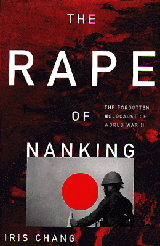GOLDSEA | ASIAN BOOKVIEW | NONFICTION
The Rape of Nankingby Iris Chang
BasicBooks, New York, 1997, 290pp, $25
A study of Japanese atrocities in Nanking from the perspective of the soldiers who committed them, their Chinese victims and the westerners who intervened to save lives.
EXCERPT:
 he Japanese strategy for Nanking was simple. The imperial army exploited
the fact that the city was blocked by water in two directions. The ancient
capital lay south of a bend in the Yangtze River that first coursed northward
and then turned to flow east. By converging upon Nanking in a
semi-circular front from the southeast, the Japanese could use the natural
barrier of the river to complete the encirclement of the capital and cut off
all escape.
he Japanese strategy for Nanking was simple. The imperial army exploited
the fact that the city was blocked by water in two directions. The ancient
capital lay south of a bend in the Yangtze River that first coursed northward
and then turned to flow east. By converging upon Nanking in a
semi-circular front from the southeast, the Japanese could use the natural
barrier of the river to complete the encirclement of the capital and cut off
all escape.
In late November, three parallel Japanese troops rushed toward Nanking.
One force traveled west under the southern bank of the Yangtze River. Its
troops poured into the Yangtze Delta, through the Paimou Inlet northwest of
Shanghai, and along the Nanking-Shanghai railway, where the Japanese air
force had already blasted away most of the bridges. These troops were led
by Nakajima Kesago, who had worked as a member of Japanese army
intelligence in France and later as chief of the Japanese secret police for
Emperor Hirohito. Not much has been written about Nakajima, but what has
been written is overwhelmingly negative. David Bergamini, author of
Japan's Imperial Conspiracy, called him a "small Himmler of a man, a
specialist in thought control, intimidation and torture" and quoted others
describing Nakajima as a sadist who packed for his journey to Nanking
special oil for burning bodies. Even his biographer, Kimura Kuninori,
mentioned that Nakajima had been described as "a beast" and "a violent
man."
Another force readied itself for a bold amphibious assault across Tai Hu, a
lake situated halfway between Shanghai and Nanking. This force moved
west from Shanghai in a route south of Nakajima's troops. Directing the
movement was General Matsui Iwane, a frail, slight, tubercular man with a
tiny mustache. Unlike Nakajima, Matsui was a devout Buddhist from a
scholarly family. He was also the commander-in-chief of the Japanese
imperial army for the entire Shanghai-Nanking region.

A third force traveled further south of Matsui's men and swerved northwest toward Nanking. Heading this force was Lietenant General Yanagawa Heisuke, a bald, short man with literary interests. Perhaps to a greater degree than most other Japanese involved in the Rape of Nanking, his life during the invasion is veiled in mystery. According to his biographer, Sugawara Yutaka, the fascist clique that took control of the Japanese military had expelled Yanagawa from their ranks because he attempted to stop their 1932 coup. After his marginalization and demotion to the reserves, Yanagawa served as a commanding officer in China and performed "great military achievements...including the surrounding of Nanking," but the military withheld his name and photograph from publication at the time. Thus Yanagawa was known to many in Japan as "the masked shogun."
ASIAN AIR ISSUES FORUM |
CONTACT US
© 1999-2003 GoldSea
No part of the contents of this site may be reproduced without prior written permission.
